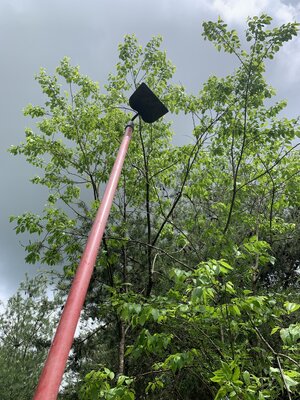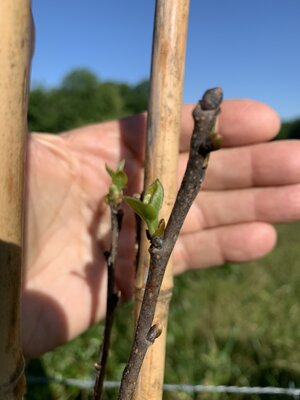A question for the experts: I ordered American persimmon seedlings from Wildlife Group last year and had a heck of a time keeping them alive with the drought, but they greened up initially at a 100% rate. The grafted females I ordered didn't ever even put on a single bud -- I explained that in the post above and was the first time I've been disappointed with anything from Wildlife Group. What would be the possibility of success with placing the ordered bareroot seedlings in one gallon rootmakers, them transplanting them into 3 gallons and planting the following year? Has anyone ever tried this? I know transplanting native grown persimmons, out of the ground, is almost an impossible task, what about root-pruning though? Would that hurt their ability to sink a tap root after putting them in the ground? I'm toying with the idea of ordering some seedlings along with my order from Blue Hill next fall. I already have all of the stuff I need to do this because of my failure with chestnuts this year.
I have not done it with persimmons but I have with apples.
Persimmons have a deep tap root and are hard to transplant because you typically don't get enough roots to support the top. You can transplant them if they are very small. I have native persimmons on my place, so the best bang for the buck is grafting male trees to female. Having said that, I did get persimmon seed from Cliff England one year. I started them in mesh flats and as soon as they lifted the seed, I moved them to 18s. I then transplanted then to 1 gals and 3 gals. They do fine as root pruned trees in my area.
Having said that, you mention drought. If you are prone to drought, root pruned trees may not be a good fit. A root pruning container system prunes the tap root first at about 4" which stimulates lateral root growth above the prune. Most occurs in the at first 4" above the prune. Subsequent containers allow for more and more lateral root growth. A root pruned tree has a very efficient root system with lots of tiny terminal root tips which is where most water and nutrients are taken up.
When we use a root pruning system, we are making a trade off. While the root system is dense and efficient, it can only use what it can reach. In an arid area in sandy soil where soil dries out quite deep, unless supplemental water is provided, a root pruned tree will struggle. Given you are in an area where regular long droughts are not common, root pruned trees will grow faster. First, energy that would normally go into a tap root to ensure survival when young, becomes available to more lateral roots and more top growth sooner. The tradeoff is that we are providing TLC for that tree (water and nutrients) in containers until the root system is large enough to reach deep enough to get to moisture.
That is why I've had zero success planting directly from 18s, good success planting from 1 gals, and great success planting for 3 gals. A 3 gal is deep enough to get access to water in my area.
Sorry for the tangent, but one should think about whether root pruning is a good match for their location before worrying about specific techniques.
Building better bare root trees with root pruning containers works well. I've done it with apples using clonal root stock where there is not tap root to prune, placing them directly in 1 or 3 gal. The size I start with depends on the size of the existing root system. The more roots I can keep in the container with them spread out evenly the better. I've actually done this indoors under lights to give apples an early start.
I have also done this with chestnuts and other trees I got from the Wildlife group. They were started in root pruning bags. Those trees eventually died, but not related to the root pruning containers. They were nut-grafted and longevity is a know issue with nut grafted trees. They also had a disease issue which contributed to the issue.
So using root pruning containers to give bare root persimmons a good TLC head start is likely a good approach...IF root pruning is a good fit for your area.



